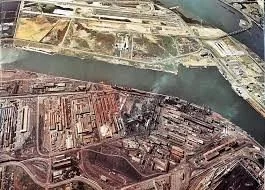Maitland’s loss of the regional capital role
From the late 1840s until about 1870, Maitland was the second-largest urban centre in New South Wales. Counting West Maitland, East Maitland and Morpeth as a single entity, it had eclipsed Parramatta and Windsor in population and was yet to be overtaken by Newcastle and its satellite mining villages. Maitland had become the ‘Hub of the Hunter’ and the ‘Capital of the North’: it served a huge hinterland, especially after the railway was extended during the 1870s beyond the Great Dividing Range and eventually to the Queensland border. Maitland thus became well connected to the Liverpool Plains and places further north such as the valleys of the Gwydir and MacIntyre rivers.
Events move against Maitland
Maitland was not to retain its regional role indefinitely, or indeed the industrial base that had developed there since the 1830s. Events in the late 1880s and the 1890s turned against the town. The railway line bridged the Hawkesbury River in 1889, making it easier for Sydney firms to compete with Maitland businesses for the custom of northern NSW. Then a disastrous flood hit Maitland in 1893, damaging businesses and probably business confidence, and that event was followed by a devastating depression which did further harm. The 1880s had been a period of considerable investment, both public (the Post Office in High St as one example) and private (EP Capper and Sons’ new emporium and expansions to several other important business houses including David Cohen & Co). But such investment was later to become significantly reduced as Maitland’s fortunes waned.
David Cohen & Co building, early 1900s
By 1890 Newcastle, its growth fuelled by coal mining, the development of new colliery villages on its western edge (like Wallsend and Minmi) and the attraction of ancillary industries, had a population much larger than that of West Maitland, East Maitland and Morpeth combined. Meanwhile, the bridging of the Hawkesbury by the railway in 1889 allowed Sydney firms to undercut some of Maitland’s region-serving and manufacturing roles. Some Maitland firms closed as a result of the increased competition, and some people from the interior who had spent the money gained from their wool clips now spent it in Sydney rather than Maitland. Maitland’s ‘golden era’ - the era of Marvellous Maitland - was over.
The twentieth century
Then, in the second decade of the twentieth century, powered by the establishment of the BHP steelworks at Carrington (an inner suburb of Newcastle), the linked manufacturing industries it attracted and growth in services (including health and education), Newcastle finally eclipsed Maitland and took over as the regional capital of the Hunter. This role remained Newcastle’s even when the steelworks closed down more than 80 years later.
The BHP steelworks at Carrington: it made Newcastle an industrial power and fuelled its growth.
(Keith Greenhaigh)
Maitland in effect lost its commercial hegemony over the northern interior of NSW. The towns of New England and the north-west (Tamworth, Armidale, Glen Innes and Moree) grew in response to agricultural development and population growth in their own trade areas, the range of goods and services provided from their main streets expanding as the thresholds needed to support them were met. Maitland ceased to be the capital of the north just as it was no longer the hub of the Hunter.
One sign of the change was that Maitland’s population growth was muted from 1900 to 1945. This was a period described by some historians as one of ‘marking time’, reflecting Maitland’s loss of status as Newcastle powered ahead, its mining villages and the small communities of Lake Macquarie steadily coalescing. After 1945, rapid growth resumed as Maitland increasingly became a dormitory of its larger coastal neighbour.
Now it is also a dormitory to the coal mining activity further up the Hunter Valley and to some extent to Sydney itself: some Maitland people commute daily or weekly to jobs in the metropolis. Maitland’s role now is quite different from the one it held in the mid-1800s, and it occupies a lower position in the urban hierarchy of NSW.
References
Arkell, H and Armstrong, HR, ‘Marking Time’ in A New History of Maitland, Council of the City of Maitland, 1983, pp47-52.
Keys, Chas, ‘Our past: Maitland’s loss of the role of regional capital’, Maitland Mercury, 1 August 2025.


